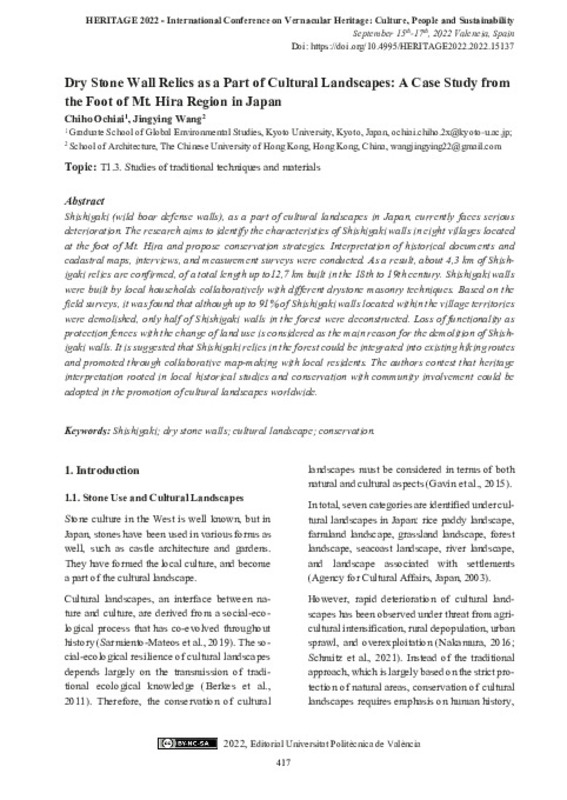JavaScript is disabled for your browser. Some features of this site may not work without it.
Buscar en RiuNet
Listar
Mi cuenta
Estadísticas
Ayuda RiuNet
Admin. UPV
Dry Stone Wall Relics as a Part of Cultural Landscapes: A Case Study from the Foot of Mt. Hira Region in Japan
Mostrar el registro sencillo del ítem
Ficheros en el ítem
| dc.contributor.author | Ochiai, Chiho
|
es_ES |
| dc.contributor.author | Wang, Jingying
|
es_ES |
| dc.coverage.spatial | east=135.943836; north=35.219972; name=Región de Hira, Japón | es_ES |
| dc.date.accessioned | 2022-10-27T11:57:31Z | |
| dc.date.available | 2022-10-27T11:57:31Z | |
| dc.date.issued | 2022-09-13 | |
| dc.identifier.isbn | 9788413960203 | |
| dc.identifier.uri | http://hdl.handle.net/10251/188847 | |
| dc.description.abstract | [EN] Shishigaki (wild boar defense walls), as a part of cultural landscapes in Japan, currently faces serious deterioration. The research aims to identify the characteristics of Shishigaki walls in eight villages located at the foot of Mt. Hira and propose conservation strategies. Interpretation of historical documents and cadastral maps, interviews, and measurement surveys were conducted. As a result, about 4,3 km of Shish-igaki relics are confirmed, of a total length up to12,7 km built in the 18th to 19th century. Shishigaki walls were built by local households collaboratively with different drystone masonry techniques. Based on the field surveys, it was found that although up to 91% of Shishigaki walls located within the village territories were demolished, only half of Shishigaki walls in the forest were deconstructed. Loss of functionality as protection fences with the change of land use is considered as the main reason for the demolition of Shish-igaki walls. It is suggested that Shishigaki relics in the forest could be integrated into existing hiking routes and promoted through collaborative map-making with local residents. The authors contest that heritage interpretation rooted in local historical studies and conservation with community involvement could be adopted in the promotion of cultural landscapes worldwide. | es_ES |
| dc.description.sponsorship | This research was supported by the Research Institute for Humanity and Nature Eco-DRR Project (14200103). | es_ES |
| dc.format.extent | 8 | es_ES |
| dc.language | Inglés | es_ES |
| dc.publisher | Editorial Universitat Politècnica de València | es_ES |
| dc.relation.ispartof | Proceedings HERITAGE 2022 - International Conference on Vernacular Heritage: Culture, People and Sustainability | |
| dc.rights | Reconocimiento - No comercial - Compartir igual (by-nc-sa) | es_ES |
| dc.subject | Shishigaki | es_ES |
| dc.subject | Dry Stone Walls | es_ES |
| dc.subject | Cultural Landscape | es_ES |
| dc.subject | Conservation | es_ES |
| dc.title | Dry Stone Wall Relics as a Part of Cultural Landscapes: A Case Study from the Foot of Mt. Hira Region in Japan | es_ES |
| dc.type | Capítulo de libro | es_ES |
| dc.type | Comunicación en congreso | es_ES |
| dc.identifier.doi | 10.4995/HERITAGE2022.2022.15137 | |
| dc.relation.projectID | info:eu-repo/grantAgreement/RIHN/Eco-DRR Project/14200103 | es_ES |
| dc.rights.accessRights | Abierto | es_ES |
| dc.description.bibliographicCitation | Ochiai, C.; Wang, J. (2022). Dry Stone Wall Relics as a Part of Cultural Landscapes: A Case Study from the Foot of Mt. Hira Region in Japan. En Proceedings HERITAGE 2022 - International Conference on Vernacular Heritage: Culture, People and Sustainability. Editorial Universitat Politècnica de València. 417-424. https://doi.org/10.4995/HERITAGE2022.2022.15137 | es_ES |
| dc.description.accrualMethod | OCS | es_ES |
| dc.relation.conferencename | HERITAGE2022 International Conference on Vernacular Heritage: Culture, People and Sustainability | es_ES |
| dc.relation.conferencedate | Septiembre 15-17, 2022 | es_ES |
| dc.relation.conferenceplace | Valencia, España | es_ES |
| dc.relation.publisherversion | http://ocs.editorial.upv.es/index.php/HERITAGE/HERITAGE2022/paper/view/15137 | es_ES |
| dc.description.upvformatpinicio | 417 | es_ES |
| dc.description.upvformatpfin | 424 | es_ES |
| dc.type.version | info:eu-repo/semantics/publishedVersion | es_ES |
| dc.relation.pasarela | OCS\15137 | es_ES |
| dc.contributor.funder | Research Institute for Humanity and Nature, Japón | es_ES |








